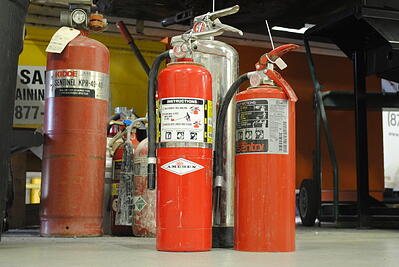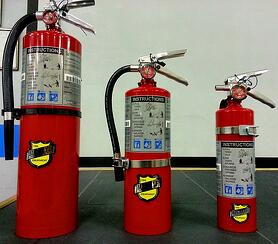Previously, we did an article on fire extinguisher service and the steps involved in monthly inspection. I wanted to take this a step further and discuss a few more topics related to fire extinguishers because we are all familiar with them, know what they are and for the most part, how they work. In order to fill in the few gaps left, we have put together this article covering training, selection, and location of fire extinguishers along with some statistics from the National Fire Protection Agency (NFPA).
So you’re ready to buy a fire extinguisher? Well first you need to know what you are using it for in order to choose the correct class of extinguisher. Below you will find a chart matching the facility with what fire extinguisher to be used:
Facility
|
Hazard
|
Extinguisher
|
| Home/Office |
Paper, computers, copiers, cloth, trash |
ABC |
| Server Room |
Servers, computers, paper, trash |
Clean agent,
carbon dioxide, water mist |
| Kitchen (Commercial) |
Grease fire |
Class K |
| Kitchen (Home/Office) |
Electrical equipment, grease fires |
Wet chemical, BC |
| Warehouse |
Gasoline, grease, oil, paint,
flammable liquids |
ABC |
| Boiler Room |
Flammable liquids |
BC |
Flammable
Liquid Storage |
Flammable liquids |
ABC, carbon dioxide |
Hospital
Operating Room |
Electrical equipment |
Clean agent,
carbon dioxide, water mist |
| Chemical Facility |
Chemicals, wood, paper, trash |
ABC |

As you can see, having an ABC fire extinguisher in most instances will take care of most fires. You simply need to be aware of the few instances where this is not the case. Electrical equipment, servers, and grease fires are the big ones to note. This requires a different type of fire extinguisher as seen above.
Now that you have your extinguisher type picked, your next task is to select an appropriate placement for the extinguisher. Remember when selecting a place for your fire extinguisher, they must be selected and positioned based on the potential type and size of fire that can occur [29 CFR 1910.157(d)(1)].
Fire extinguisher locations should be:
- Easily accessible
- Not blocked by equipment or other materials
- Near normal paths of travel
- Near entrance and exit doors
- Readily visible
- Mounted on a wall or placed in a fire extinguisher cabinet
Fire extinguisher travel distance varies on its classification:
 Once a fire extinguisher has been selected and placed in compliance with OSHA/NFPA standards, you then need to know how to use it. Training for yourself and/or employees is a very important step and should not be overlooked. The unfortunate reality, as you’ll see further below via the NFPA stats, is that fires happen all the time. Having properly learned how to use an extinguisher can save someone’s life. Below you find training specifics, as presented by the 1910.157 OSHA standard guidelines, as well as a few tips for how to engage employees further with hands-on training.
Once a fire extinguisher has been selected and placed in compliance with OSHA/NFPA standards, you then need to know how to use it. Training for yourself and/or employees is a very important step and should not be overlooked. The unfortunate reality, as you’ll see further below via the NFPA stats, is that fires happen all the time. Having properly learned how to use an extinguisher can save someone’s life. Below you find training specifics, as presented by the 1910.157 OSHA standard guidelines, as well as a few tips for how to engage employees further with hands-on training.
OSHA Training Standard Guidelines – 1910.157
- Have all employees who are expected to use fire extinguishers in an emergency been trained in the principles of extinguisher use and the hazards involved? [(g)(1)]
- Are employees trained when initially hired and then at least annually thereafter? [(g)(2)]
- Have all employees specifically designated as emergency responders in your emergency action plan (fire brigades, for example) been trained to use appropriate fire-fighting equipment? [(g)(3)]
- Do these specially designated employees receive training when they are initially assigned their special duties and at least annually thereafter? [(g)(4)]
Tips for hands-on training (to further engage & educate employees):
- Simulate various fire situations

- Include different types of fires
- Consider using digital fire simulators
- Train anywhere, safer than conventional fire extinguisher training, different difficulty levels, no recharging extinguishers
- Have employees work with varying sizes of extinguishers
- Help employees to understand the potentials and limits of each type
- Teach employees to maintain proper distance from fires
- This is dependent on the size of extinguishers used and type of fire
- Make sure to demonstrate how to properly move away from a fire once it is believed to be under control
- Teach employees to check the pressure gauges and test extinguishers before approaching a fire.
- An excellent learning tool can include having trainees select from multiple training extinguishers where one or more are not fully charged
- Keep class sizes small, ideally fewer than 20 students at a time.
- This makes it easier for everyone to participate and stay engaged
- Allow all trainees to extinguish the fire and provide them with opportunities to refine their technique and retry if they fail
FIRES IN THE U.S. (Provided by NFPA)
In 2012, there were 1,375,000 fires reported in the United States. These fires caused 2,855 civilian deaths, 16,500 civilian injuries, and $12.4 billion in property damage.
- 480,500 were structure fires, causing 2,470 civilian deaths, 14,700 civilian injuries, and $9.8 billion in property damage.
- 172,500 were vehicle fires, causing 300 civilian fire deaths, 800 civilian fire injuries, and $1.1 billion in property damage.
- 692,000 were outside and other fires, causing 60 civilian fire deaths, 825 civilian fire injuries, and $813 million in property damage.
 The 2012 U.S. fire loss clock a fire department responded to a fire every 23 seconds. One structure fire was reported every 66 seconds.
The 2012 U.S. fire loss clock a fire department responded to a fire every 23 seconds. One structure fire was reported every 66 seconds.
- One home structure fire was reported every 85 seconds.
- One civilian fire injury was reported every 32 minutes.
- One civilian fire death occurred every 3 hours and 4 minutes.
- One outside fire was reported every 46 seconds.
- One vehicle fire was reported every 156 seconds.
If you want your employees to use fire extinguishers correctly and effciently in an emergency, you must make sure they are fully trained. For more information, feel free to check out our fire extinguisher training course here:




 Once a fire extinguisher has been selected and placed in compliance with OSHA/NFPA standards, you then need to know how to use it. Training for yourself and/or employees is a very important step and should not be overlooked. The unfortunate reality, as you’ll see further below via the NFPA stats, is that fires happen all the time. Having properly learned how to use an extinguisher can save someone’s life. Below you find training specifics, as presented by the 1910.157 OSHA standard guidelines, as well as a few tips for how to engage employees further with hands-on training.
Once a fire extinguisher has been selected and placed in compliance with OSHA/NFPA standards, you then need to know how to use it. Training for yourself and/or employees is a very important step and should not be overlooked. The unfortunate reality, as you’ll see further below via the NFPA stats, is that fires happen all the time. Having properly learned how to use an extinguisher can save someone’s life. Below you find training specifics, as presented by the 1910.157 OSHA standard guidelines, as well as a few tips for how to engage employees further with hands-on training.
 The 2012 U.S. fire loss clock a fire department responded to a fire every 23 seconds. One structure fire was reported every 66 seconds.
The 2012 U.S. fire loss clock a fire department responded to a fire every 23 seconds. One structure fire was reported every 66 seconds.
 Luckily for us, this is a simple 7 step process that will become routine in time. The first two things you must know before starting an inspection of your fire extinguishers are:
Luckily for us, this is a simple 7 step process that will become routine in time. The first two things you must know before starting an inspection of your fire extinguishers are: must prevent the powder from settling. Go ahead, give it a shake. While its in your hands, is it any lighter than usual or than you'd expect? Call your servicing company (or
must prevent the powder from settling. Go ahead, give it a shake. While its in your hands, is it any lighter than usual or than you'd expect? Call your servicing company (or Now that the extinguisher is placed correctly and the label is facing outward, check the pin or safety seal. It should still be intact; if not, you should replace the fire extinguisher.
Now that the extinguisher is placed correctly and the label is facing outward, check the pin or safety seal. It should still be intact; if not, you should replace the fire extinguisher. Congratulations, your monthly inspection is complete. Be sure to sign your initials on the tag when it has space for monthly inspections. This verifies that the extinguisher is up-to-date and also proves to OSHA (if need arises) that a monthly inspection has been performed.
Congratulations, your monthly inspection is complete. Be sure to sign your initials on the tag when it has space for monthly inspections. This verifies that the extinguisher is up-to-date and also proves to OSHA (if need arises) that a monthly inspection has been performed.